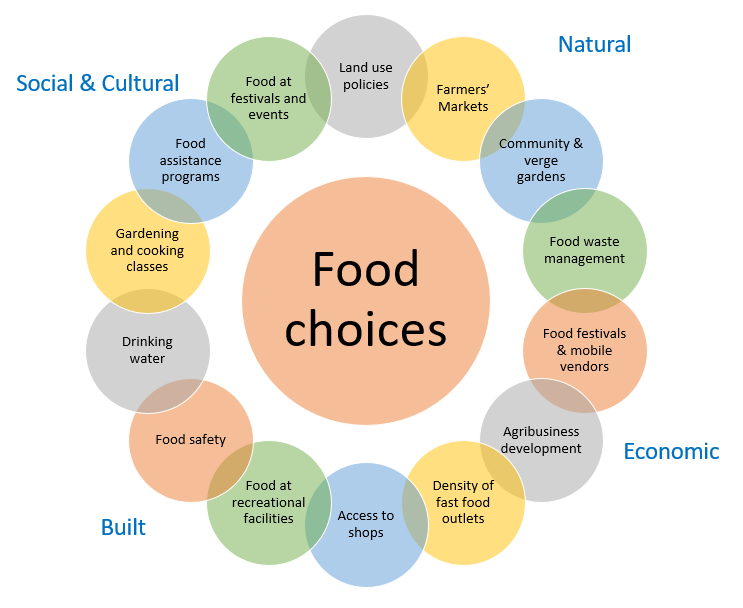Local Food Environments
Local food environments are all the processes involved in keeping us fed. They impact on the access, availability, and adequacy of food within a community or region and include the following factors:
- natural (e.g. local agriculture, food producers, green public spaces and community gardens)
- built (e.g. food outlets and transport infrastructure)
- economic (e.g. local food businesses; agritourism; community programs for low-income households)
- social and cultural (e.g. farmers' markets; cultural and community events; Meals on Wheels; cooking and nutrition education programs; food relief programs).
Local food environments that promote sustainable food systems also help maintain food security and nutrition for future generations.
Sustainable food systems must:
- be profitable (economic sustainability)
- provide benefits for society (social sustainability)
- have a positive or neutral impact on the environment (environmental sustainability).
Role of local governments
Healthy people like to live, work, learn and play in vibrant communities, and local governments play a key role in creating these environments. Local governments influence the food available in our neighbourhoods, and how we access them, through their planning and regulatory activities local community facilities, programs and events. Evidence shows that local food environments that make healthier food and drink available and accessible; improve physical and mental health, increase food literacy, reduce local food insecurity, reduce food and resource waste, and reduce environmental impact within the community.
Government policies and actions can help create supportive environments for healthy eating
In Western Australia (1), around 90% of the adult population believe that government financial support is important for improving the local food environment. They believe governments should:
- support schools to provide better nutrtrion information and programs
- provide nutrition publications for the public
- monitor the quality of the food supply
- work with the food inducstry to increase availability of healthy foods
- research 'what Western Australians are eating' and how our diet is changing over time.
Local governments influence our daily food options

Unfortunately, many current food environments in Australia do not provide equal access to safe, sustainable, high-quality, healthy food for everyone. While interactions are complex, our local neighbourhoods, local economies, social situation, dietary intake and food security are linked to our risk of chronic disease and unhealthy weight. People with physical access to nutritious foods are more likely to consume a healthy diet and less likely to be an unhealthy weight.
Supporting healthy eating is not the responsibility of local government alone. The responsibility is shared among all levels of government and other stakeholders in the community. As the level of government closest to the community, local governments can, and are active in, influencing the local healthy food environment to improve access, price, availability and sustainability of healthy food choices.
Improving the local food environment goes beyond just the positive impact on the individual’s health and wellbeing. Broader social, cultural and economic benefits can also be gained for local governments and the community.
Improving the local food environment supports the wider council agendas of:
- active living
- economic development and supporting local businesses
- creating sustainable and resilient environments responsive to climate change
- making progress towards Sustainable Development Goals
- encouraging tourism
- facilitating social connection in the community.
Local governments focused on improving the local food environment can:
- provide opportunities for greater collaboration between local retailers and growers
- facilitate social cohesion and strengthen communities using food as a connector
- reduce health inequities by increasing access, availability and affordability of local healthy food options for all, particularly for the most vulnerable. This aligns with the State Public Health Plan for Western Australia, Objectives and Policy Priorities for 2019-2024, and the requirements under the Public Health Act 2016, Section 45 Local public health plans
- help build a stronger and more sustainable local economy and more social support networks, which in turn improve food security and the health of local residents as the social and environmental determinants of health improve.
(1) Miller, MR and Miller, SA. (2017) Nutrition Monitoring Survey Series 2015 Key Findings, Department of Health, Western Australia. Accessed from https://ww2.health.wa.gov.au/-/media/Files/Corporate/general-documents/Population-health/PDF/Nutrition-monitoring/Nutrition-Monitoring-Survey-2015.pdf
